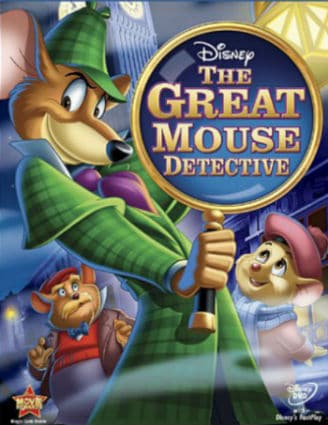
Welcome to Revisiting Disney! Today, we’re looking at that movie which introduced Sherlock Holmes to a new generation, The Great Mouse Detective! Like always, I have labeled each category so if you want to skip to the parts that interest you most, feel free. And, of course, if you have any thoughts, burning or otherwise, please share in the comments!
BACKGROUND OF THE GREAT MOUSE DETECTIVE
The Great Mouse Detective was released on July 2nd, 1986 and was directed by John Musker and Ron Clements (the team that would go on to direct The Little Mermaid, Treasure Planet, The Princess and the Frog, Aladdin, and the soon to be released Moana), with Dave Michener and Burny Mattison. The two had not been involved in The Black Cauldron and had been working on another project, this one.
Roy Disney, after the regime change at the Disney Studios (see last week’s post for more information on that event), discovered that the project the two were working on was called Basil of Baker Street, based on the book of the same name by Eve Titus. The plot is basically Sherlock Holmes with mice.
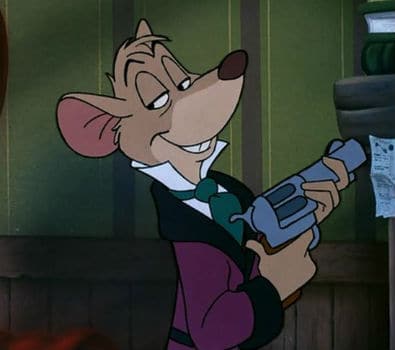
Photo: Disney
Disney liked what he saw and brought in Katzenberg and Eisner (Chairman of Walt Disney Pictures and Chairman of the Walt Disney Company, respectively), to look at the storyboard for the proposed film. The other two were just as enthusiastic as Roy and gave the green light to the project.
At the same time, trying to rebuild and revitalize a studio full of animators that Bob Thomas calls “very depleted and demoralized,” the three new leaders hired Peter Schneider as a manager of the animation (Thomas 1992: 117). Although Schneider had no background in animation (he had been involved in theater), the power triangle of Disney, Eisner, and Katzenberg discovered that he was a quick learner, and, importantly, he saw animation as an art and animators as artists.
While The Great Mouse Detective was underway, Disney worked with Katzenberg to grow the animation department. In what was considered the largest expansion since the Days of Walt, the Animation Department grew from less than 200 to over 600.
The new management also had a plan to increase revenue and decrease spending; they would work on multiple pictures at a time and have a yearly film release. The leadership would make a tight budget and stick to it (and the schedule would also be strict).
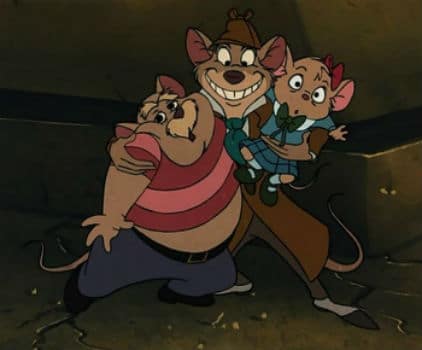
Photo: Disney
Thomas calls The Great Mouse Detective “a happy surprise, filled with humor and inspired animation, and helped immeasurably by the voice of Vincent Price as the arch-villain Ratigan,” (Thomas 1992: 117). For all purposes, it was a much-needed assist on the road to recovery after The Black Cauldron.
MUSIC
With music by Henry Mancini, the man behind the score of Breakfast at Tiffany’s, The Thorn Birds, and many other great shows and films, The Great Mouse Detective has a knack for the suspenseful type of music that you expect from a detective movie, with a fun lilt at times, which is more in line for a Disney movie. The combination of the two is fun and catchy, making this another in a great line of Disney scores.
Unlike The Black Cauldron, the characters in this film do sing some of their numbers. One of these numbers, “Let Me Be Good to You,” was actually almost cut, because it was a lady mouse singing at a bar and was considered a bit too adult to put into a Disney family film.
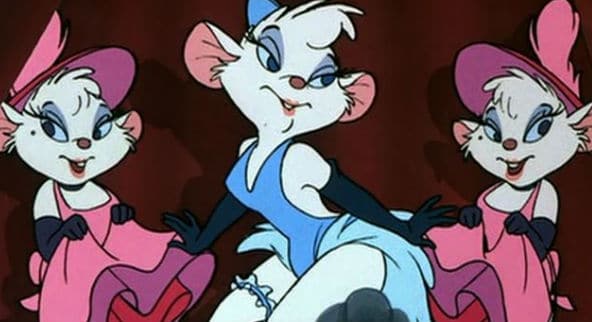
Photo: Disney
It was able to stay after an appeal that it was technically a Cabaret act with harmless lyrics and, because it was sung by a mouse, not a human, it was fine. Supposedly, Liza Minnelli and Madonna were both at one point going to sing the number, but Melissa Manchester was cast instead.
The other songs, Ratigan’s villain song and the “Goodbye So Soon” number were, near as I can tell, sung to wonderfully creepy perfection by the amazing Vincent Price, a giant of the horror film industry, including many adaptations of the works of Edgar Allan Poe and House on Haunted Hill.
Like Boris Karloff, Christopher Lee, and Peter Cushing, Vincent Price was said to actually be one of the nicest people on the planet, despite usually playing villains. According to the IMDB, this role allowed him to fulfill a life-long dream, to be a character in a Disney animated film.
ANIMATION
With the spirits of the animators at an all-time low after The Black Cauldron and the walkout of a large portion of their team, The Great Mouse Detective was a chance to rebuild the team and improve morale. It also continued to develop new technologies first used in The Black Cauldron.
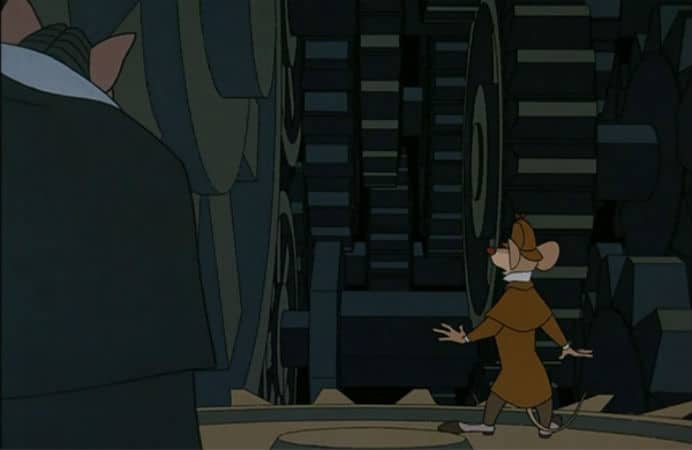
Photo: Disney
The scene in the end where Basil is behind the face of Big Ben is one of the first major uses of computer animation in a film since the entire background was CG and the characters were traditionally animated. It’s a really beautifully done and technologically fascinating scene because of that blending.
Supposedly, Ratigan was supposed to be less of an imposing physical character, but because of his actor, Vincent Price, some changes were made. The animators also used his gestures and facial expressions in creating the character.
According to my new favorite book, The Disney Villain by Ollie Johnston and Frank Thomas, the animation of Ratigan, by Glen Keane, was based on a picture of a group of railroad men in 1800’s London, and that there was one guy, dressed to the nines, smoking a cigar and wearing a top hat and what I assume was a smarmy expression. Keane knew he had his guy, and Ratigan was born.
Ratigan is a sewer rat that dresses and acts like a king until he gets angry. He is “emotional and theatrical,” as well as having confidence in his own abilities (Johnston and Thomas 1993: 176). The transition of Ratigan from his poised and polished self to the sewer rat that he actually is fits in with the emotional and theatrical ways of the character and makes the scene in Big Ben very exciting.
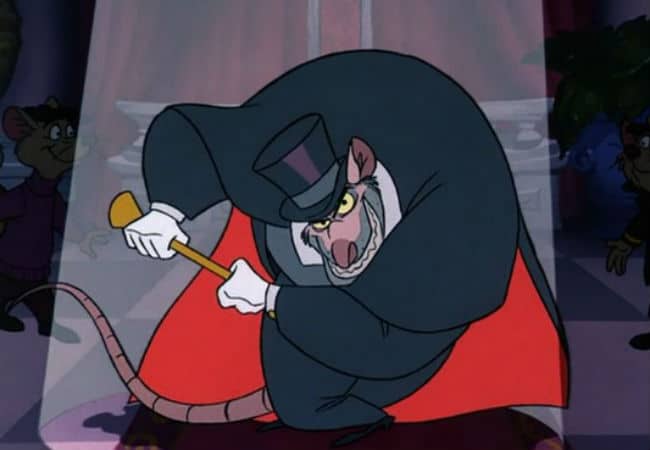
Photo: Disney
Keane also said that he wrote childhood stories for both Basil and Ratigan, to help himself understand where the characters came from, what their connection might be, and what drove them. I would love to read those short stories.
The conflict between management and animators didn’t disappear overnight. Some crew mentioned that the slower parts that built the story were often cut to make the finished product more exciting. This wasn’t a bad thing, it was just a case, Johnston and Thomas point out, of two different visions of a film colliding. I think it all works beautifully, but that’s just my personal opinion. At the very least, it helped pave the wave for the Disney Renaissance that would begin in just a few years.
THE PLOT
Our story opens is set in London in 1987. We open with a toymaker, Flaversham, and his little daughter Olivia, but there is also a sinister figure in the area. When it becomes clear that someone is trying to open the door, Flaversham hides Olivia and tells her to stay quiet. This was just in the nick of time, because soon after, a bat that gave me nightmares as a child bursts in, and after a scuffle, kidnaps the toymaker. Olivia comes out of her hiding place and begins to search for her father.
We next meet Doctor David Q Dawson, our narrator, recently returned from military service in Afghanistan, and looking forward to a calm life. He comes across poor, lost Olivia, trying to find Basil of Baker Street. Not one to leave a small child alone in London without any adults, he tells her that he’ll take her to see the famous detective.
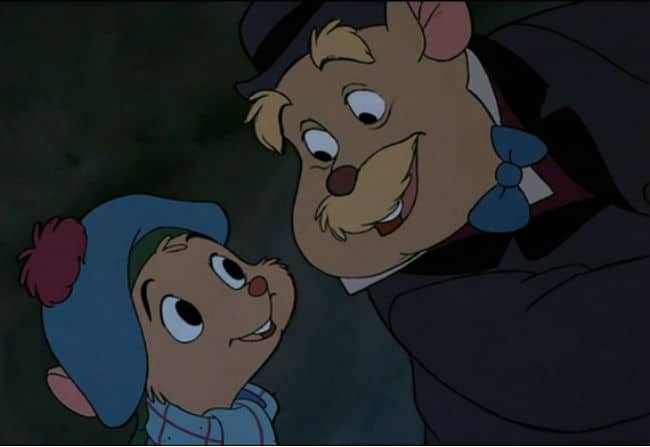
Photo: Disney
When they get there, Basil is out, so his housekeeper tells them they can come in and wait. In a grand entrance, Basil bursts in, wearing a disguise and convinced that he has finally caught someone. In a scene that pays homage to Watson and Holmes’ first meeting in “A Study in Scarlet,” Basil deduces that Dawson is a doctor.
When the experiment proves to be a dead end, Basil turns to his violin for solace and, despite Olivia’s best efforts, doesn’t show interest in her case until she mentions that she doesn’t have a mother. He is determined to not get involved and tells her that he has no time for lost fathers. When Olivia tells him that she didn’t lose her father, a bat with a peg-leg took him, Basil realizes that his nemesis, Professor Ratigan, is behind the disappearance and agrees to take the case.
Basil tells his guests about his nemesis, Professor Ratigan, calling him the Napoleon of Crime and mentioning that he has been trying to capture him for years. Basically, Ratigan is Basil’s Moriarty. We then move to Ratigan’s hideout, where Flaversham is making a mouse-sized robot and making sure that it can pour and stir tea. We don’t know the plan, but it can’t be good.

Photo: Disney
When Ratigan comes to check on the progress of the robot, Flaversham tells him that he can kill him if he wants to, but he, Flaversham, wants no part in the scheme. Ratigan counters by telling him that he is going to have his daughter brought to the lair, and if the robot is not done, Olivia could get hurt.
To save his daughter, Flaversham agrees to finish the project. Ratigan then sends Fidget, the peg-leg bat, after Olivia and outlines his scheme to his men, to remove the Queen from power and take over the empire. He also sings one of the best Disney Villain Songs, where he outlines his earlier achievements and promises that this is his best crime yet.
Also, here we learn that apparently, Ratigan doesn’t like being reminded that he’s a rat, trying to be more civilized than the average sewer rat. When one of his henchmen slips up and uses that word, Ratigan calls out his giant pet cat Felicia, who eats his badly behaved minions. He reminds me a lot of Captain Hook, foppish and refined but also pretty bloodthirsty and cold.

Photo: Disney
Back in Basil’s house, our hero is puzzling over the facts as he knows them. Fidget appears, but his attempt to grab Olivia results in his dropping his hat. This provides our hero with a way to track him down, using Toby. After a brief discussion that results in his sitting on and breaking his violin, and despite Basil’s determination to leave her behind, Olivia goes with Dawson and Basil.
When they reach the house at 221B Baker Street above them, Sherlock Holmes and Watson are getting ready to go to a concert. This brief speaking cameo of Sherlock, talking about going to the performance, was actually part of Basil Rathbone’s reading of “The Red-Headed League,” tying in both Rathbone and more of Doyle’s work.
It turns out that Toby is a dog who lives with Sherlock Holmes, another tie-in to the series because Holmes did borrow a dog named Toby during “The Sign of Four.” Toby is able to track Fidget to a toy factory, where he is taking gears, tools, and play uniforms of the Queen’s guard. Basil, like the audience, wonders what on earth all these things together mean.
While Basil is investigating the toy store (actually, it’s the creepiest toy store ever), Fidget turns on every noise-making toy he can get to. This both allows him to cause a distraction so he can get away, and will hopefully allow him to grab Olivia. His trick works and the sequence where Basil is chasing after him trying to save Olivia is a wonderfully animated one.
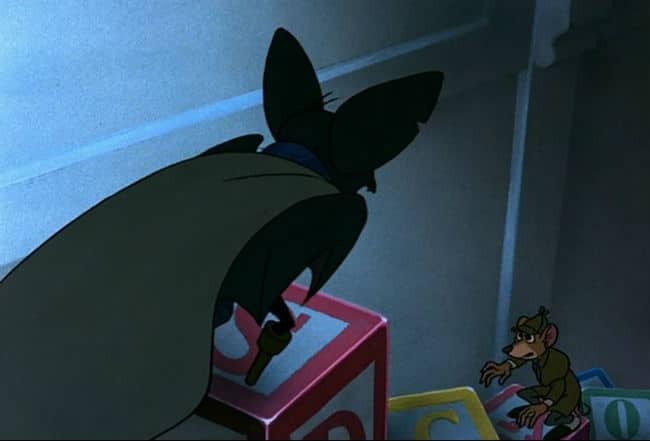
Photo: Disney
Even though Basil was unable to catch Fidget, the bat had dropped the list Ratigan had given him, something that Dr. Dawson picked up. When Ratigan finds out why Fidget doesn’t have the list; he was busy running from Basil; he realizes that Basil is on the case. Sick of Basil’s interfering in his schemes, he decides to set a trap for his foe and end their battle once and for all. Meanwhile, using the list that Fidget dropped and science, Basil is able to find the entrance to Ratigan’s hideout, a seedy pub where the waterfront and the sewers meet. While there, he and Dawson pretend to be sailors looking for their friend Ratigan.
Of course, this results in their drinks being drugged (because no one likes Ratigan, in secret, apparently). Fidget appears, to the delight of Basil, but a drunk/drugged Dr. Dawson ends up on stage with the Cabaret Act. When he falls onto the piano, the piano player’s attempt to get him off the instrument inadvertently leads to a fight, and in the midst of the fight, Fidget exits through the secret tunnel.
Basil and Dawson are able to follow him to Ratigan’s hideout. They’re in the process of freeing Olivia when Ratigan appears with all his men. Telling Basil that he had been expecting him, Ratigan laughs at his foe, who he was able to beat in a battle of wits and reminds Basil that he failed. This causes Basil to doubt himself and it seems like he’s both upset at being outwitted and by being unable to save the Empire.
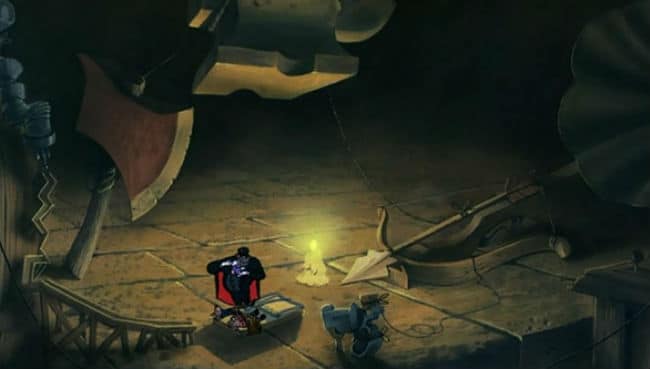
Photo: Disney
Ratigan ties our heroes to a mousetrap (part of a truly elaborate death plan that might be the definition of overkill). Ratigan explains how they will die and then heads off to Buckingham Palace. When Dawson wonders what Ratigan is going there for, Basil says it’s obvious, “The Queen’s in danger and the Empire’s doomed.”
The invention that Flaversham has been working on, it turns out, is a life-sized robot version of the Queen. After replacing the real Queen and sending the Queen to Felicia the cat to be eaten, Ratigan uses the robot-Queen to place himself on the throne. With a long list of new laws, Ratigan begins to settle in as ruler. Meanwhile, Dawson, knowing Basil can save them, angrily tells his friend that if he’s given up they should just set the trap off early.
Basil chuckles weakly, but Dawson has gotten through to Basil, who figures out how to escape, using the different parts of the trap. This also frees Olivia. The trio find Toby and then race to Buckingham Palace, where they save the Queen from being eaten while Toby chases Felicia into a pen full of the royal guard dogs.
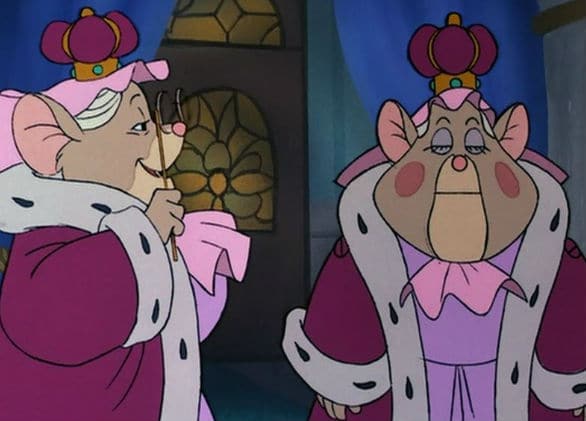
Photo: Disney
Exposing Ratigan’s plot by destroying the robot, the real Queen, and her subjects fight back against him and his henchmen. The good guys appear to be winning, until Ratigan grabs Olivia and Fidget, running to his dirigible. Basil, Dawson, and Flaversham give chase through the skies of London in a balloon of their own. Ratigan, in an attempt to lighten the load, throws Fidget overboard (the death toll in this film is rather high, isn’t it?). When Basil jumps to the dirigible in an attempt to save Olivia, neither he nor Ratigan notices that they are about to crash into the face of Big Ben.
Inside the clock, Ratigan tries to sneak up on Basil to push him into the gears, but Olivia warns him in time. Trying to escape, she bites Ratigan’s hand, and he drops her and kicks her into the one of the turning gears. She’s trapped, and likely to be squashed unless someone saves her. Catching Ratigan’s cape in another gear, Basil does so in a truly epic way, grabbing a chain and riding it up to the gear, grabbing her in the nick of time.
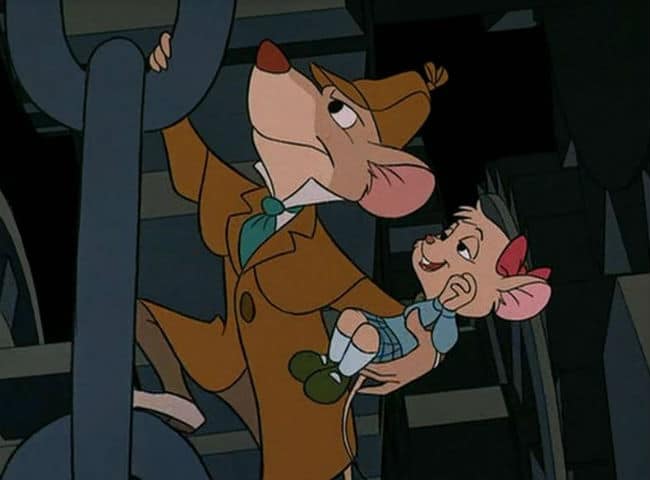
Photo: Disney
Ratigan is furious, and in a terrifying twist, loses his cool and becomes a giant, scary rat. He is determined to kill Basil and is apparently not above fighting dirty to get there. Luckily, Basil manages to pass Olivia off to Dawson and her father before Ratigan reaches them. The fight between Ratigan and Basil moves to the clock face of Big Ben. After giving Basil a bit of a beating while Dawson and Flaversham try to save him, Ratigan succeeds in pushing Basil off of the hour hand and believes he has won.
Basil, however, has managed to grab a hold of the seat that powered Ratigan’s dirigible, still embedded in the clockface. When the clock chimed the hour, the vibration shakes the whole thing and Ratigan tumbles to his death. Unfortunately, he grabs Basil on the way down.
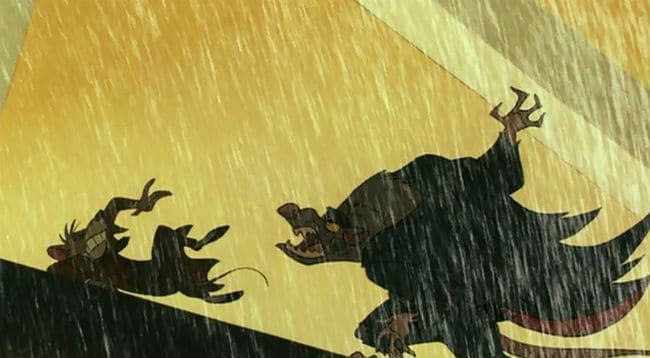
Photo: Disney
Of course, this story is Basil’s, and he was holding the seat of the dirigible when he fell. This allows him to propel himself back up to his friends. Honored by the Queen, having saved Olivia and her father, Basil has had a good few days, overall. When another case comes knocking, he offers Dr. Dawson a position as his associate. Dr. Dawson says yes, and tells us that though they solved many cases together, the first was the most memorable.
The story ties into Doyle’s Holmes in several other ways. First, Ratigan is based on Moriarty, Holmes’ nemesis, and like with Holmes and Moriarty,Ratigan and Basil both seem to fall to their deaths, but only Ratigan actually dies. Basil of Baker Street is named after Basil Rathbone, and the voodoo doll Basil in Ratigan’s lair is based on the illustrations of Paul Galdone for the original book.
THE LEGEND OF SHERLOCK HOLMES (SOURCE MATERIAL)
Like with several of the other films that I have mentioned here, The Great Mouse Detective was one of my favorites because, like Robin Hood and King Arthur, Sherlock Holmes is one of my favorite things. Due to the popularity of shows like “Sherlock” and “Elementary,” plus the classic Basil Rathbone films and the newer Robert Downey Jr. Sherlock Holmes, it seems that I am not alone in my feelings.
Wanting to be a detective when I grew up was between my astronaut/ballerina and President phases, and this character certainly helped (of course, Nancy Drew and the Hardy Boys were also to blame). As I got older, I began to read more of the Sherlock stories, and they are all fabulous and highly recommended.
“The Adventures of Sherlock Holmes” were published in the magazine The Strand from July 1891 to December 1892, “The Memoirs of Sherlock Holmes” from December 1892 to November 1893, “The Return of Sherlock Holmes” from October 1903 to 1905. Additionally, there was a “Collection of Holmes Adventures,” and “The Casebook of Sherlock Holmes,” in addition to several novels. The novels include “A Study in Scarlet,” “The Sign of Four,” “The Hound of the Baskervilles,” and the “The Valley of Fear.”

Photo: Disney
It has always struck me as sad that Sir Arthur Conan Doyle hated Sherlock Holmes more than any other character he wrote, and that was the one that fans loved the most and refused to let die. Luckily, the talented writer was able to bring Sherlock Holmes back from the dead by just making the death an elaborate scheme. I’ll be honest, Sherlock Holmes can be a bit of a jerk, but he’s so smart and the cases are so compelling that I always wanted to know how he did it anyway.
Something fascinating about this character to me is the way that he so multi-faceted. Sherlock is never the same. Whether he’s played by Robert Downey Jr, Benedict Cumberbatch, Johnny Lee Miller, Basil Rathbone, Peter Cushing, Ronald Howard, John Barrymore, and even a mouse, all are different.
Each actor is able to portray a different part of the character and while some things remain, there are different aspects that can be radically different and still part of the character as Doyle wrote him. Robert Downey Junior’s Sherlock is just as accurate as Benedict Cumberbatch’s, which is just as accurate as Johnny Lee Miller’s, even though they are radically different.
Before there was Doyle, other author’s were writing detective stories. These include Edgar Allan Poe (whose detective stories are, as can be expected, amazing), Charles Dickens, Emile Gaboriau, and Mary Elizabeth Braddon. It’s a great tradition, I think.
On the book jacket for The Rivals of Sherlock Holmes, the authors point out that the Sherlock Holmes stories got people very interested in the genre of detective fiction. Not only do we have Holmes himself, there were other authors writing at the same time, in a very similar style in England, the rest of Europe, and America.
There are a wide variety of characters that follow the Sherlock Pattern, including several female detectives, and a slew of authors that wrote some wonderful detective fiction. Authors that might be interesting include Wilkie Collins, Ernest Bramah, R. Austin Freeman, Melville Davisson, Arthur Reeves, and Anna Katherine Green. If you like this genre, specifically the style of Sherlock Holmes, check them out!
Of course, there are the series of books that have people related to or descended from Sherlock Holmes, that use their heritage or skills learned from Sherlock to solve crimes (the Enola Holmes Mysteries focuses on his sister), and you also get stories of the mouse version of Sherlock, like The Great Mouse Detective.
This particular movie is based on Basil of Baker Street by Eve Titus, which I’m actually reading right now. It’s a delightful spin on the Sherlock Holmes story, and Sir Arthur Conan Doyle’s’ son wrote to the author and told her that he loved the book and that his father would have loved it as well. There are also multiple books in the series.
On the back of the book, the tag is that Basil, the great mouse detective himself, lived in the basement of Sherlock Holmes’ house at 221B Baker Street, and as an admirer of Holmes, he learned how to be a great detective from listening to Holmes work and explain his process to Watson.
I’m excited to dig into this book because it looks like a quick and fun read. Have you read it? Let me know in the comments!
The 1980’s
Since we’ve talked about the entertainment industry and a bit of the political climate of the 1980’s for the past few weeks, this week I’m going to mention something the History Channel calls Reaganomics. Before we get there, we have to back up a bit to the beginning of the decade.
Around the time of the 1980 Election, a new group of liberals appeared on the scene and called themselves “Reagan Democrats,” and they helped secure Ronald Reagan’s victory. As a former actor, Ronald Reagan seemed optimistic, friendly, reassuring, and charismatic, something that we were looking for after the chaos of the 1970’s.
Reagan campaigned on tax cuts and making the government smaller, and when he was elected he did work to reduce government spending and provide tax cuts to both the average citizen and the company. The idea behind his tax cuts and other changes was that if people had more money they spend more of it and perhaps even invest it in other corporations. This idea is called “trickle- down economics.”
Unfortunately, according to the History Channel, the plan didn’t turn out as Reagan had hoped. In the beginning of the decade, the United States was experiencing a terrible recession, the worst since the Great Depression. Luckily, the economy righted itself out again and, despite the stock market crash of 1987, a rather mixed track record, and a large amount of federal debt, people were still optimistic for the future.
LESSONS LEARNED
I suppose the big lesson is that there is always someone smarter than you. Even if there isn’t, and you have someone generally equal to you, like Basil and Ratigan, you will each outsmart the other at different times. The trick is what you do when your nemesis beats you. Do you rally and try to make sure that you win the next round, or do you give up? It seems like Basil rallied for their entire professional relationship, with one moment of surrender, before rallying and eventually winning.
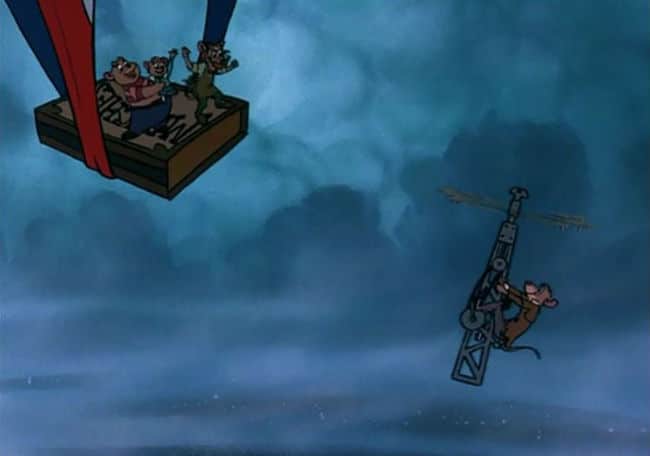
Photo: Disney
The other lesson is that friends are important. Basil only got out of his funk after being outsmarted by Ratigan after Dawson talked him out of it, and not necessarily nicely. Our friends are always there for us, whether encouraging us or offering much-needed criticism (in a loving way). We also fight to save our friends, because they’re worth it.
DOES IT HOLD UP?
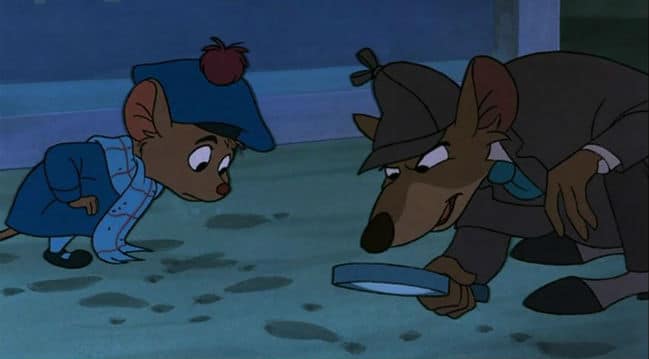
Photo: Disney
The Great Mouse Detective, to me, is an underrated gem of a movie. I don’t think anyone really hates it, and it did good things for the Studio while furthering the computer technology that had been introduced in The Black Cauldron. Overall, I think it still holds up and is certainly one of my favorite Disney movies. Plus, it’s part of a rich literary and film tradition; we’re still adapting, reading, and talking about Sherlock Holmes and for some of us, Basil of Baker Street was our first introduction to that tradition.
What do you think about The Great Mouse Detective? Sound off below…
For next week: Oliver & Company
If you enjoyed this post and the others in the Revisiting Disney series, and have found yourself wishing that you could find them all in one convenient and bound book with eight extra essays, there is an option for you! Check out A Journey Through Disney: My Look Back Through Disney Canon, now available on Amazon as both a Kindle book ($4.99) and a paperback ($11.99).
OTHER SOURCES:
https://thewaltdisneycompany.com/about-disney/disney-history
http://www.imdb.com
http://studioservices.go.com/disneystudios/history.html
http://www.history.com/topics/1980s
Bailey, Adrian. Walt Disney’s World of Fantasy. Everest House Publishers. New York, New York. 1982.
Finch, Christopher. The Art of Walt Disney: From Mickey Mouse to the Magic Kingdom. Harry N. Abrams, Inc. New York, New York. 1975.
Johnston, Ollie and Frank Thomas. The Disney. Hyperion. New York, New York. 1993.
Sale, Roger. Fairy Tales and After: From Snow White to E.B. White. Harvard University Press. Cambridge, MA, 1978.
Tatar, Maria. The Annotated Classic Fairy Tales. W.W. Norton and Company. New York and London, 2002.
Thomas, Bob. Disney’s Art of Animation From Mickey Mouse to Hercules. Hyperion. New York, New York. 1992.
Wright, Gordon. The Ordeal of Total War: 1939-1945. Harper Torchbooks, Harper & Row. New York, Hagerstown, San Francisco, and London, 1968.
ARE YOU A ROMANCE FAN? FOLLOW THE SILVER PETTICOAT REVIEW:
 Our romance-themed entertainment site is on a mission to help you find the best period dramas, romance movies, TV shows, and books. Other topics include Jane Austen, Classic Hollywood, TV Couples, Fairy Tales, Romantic Living, Romanticism, and more. We’re damsels not in distress fighting for the all-new optimistic Romantic Revolution. Join us and subscribe. For more information, see our About, Old-Fashioned Romance 101, Modern Romanticism 101, and Romantic Living 101.
Our romance-themed entertainment site is on a mission to help you find the best period dramas, romance movies, TV shows, and books. Other topics include Jane Austen, Classic Hollywood, TV Couples, Fairy Tales, Romantic Living, Romanticism, and more. We’re damsels not in distress fighting for the all-new optimistic Romantic Revolution. Join us and subscribe. For more information, see our About, Old-Fashioned Romance 101, Modern Romanticism 101, and Romantic Living 101.

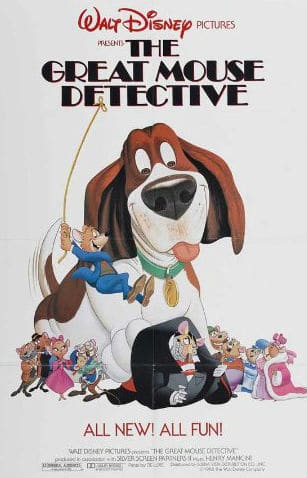
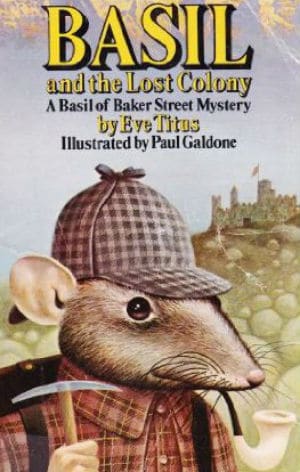
The Great Mouse Detective is forgettable, but endearing and solid.